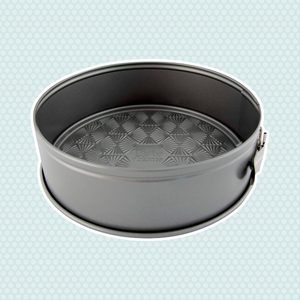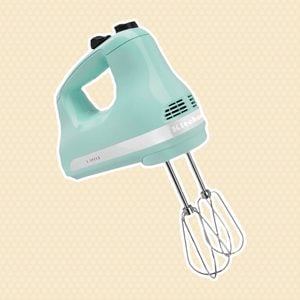Making cheesecake doesn't have to be intimidating. These recipes, tips and techniques will help you make a restaurant-quality dessert at home.
The Ultimate Guide to Baking Cheesecake
There’s a reason you’ll find a slice of cheesecake on just about every restaurant dessert menu. With its wide variety of flavors ranging from salted caramel cappuccino to swirls of jammy filling, this decadent treat is the perfect ending to almost any meal.
And while cheesecake may look intimidating to make at home, it’s actually quite simple (especially if you use these easy cheesecake recipes). We’ll introduce you to our best recipes, time-tested techniques, must-have gear and more. Pretty soon you’ll be serving up slices better than any spot in town.
 Love to bake? Subscribe to the Bakeable newsletter and join our baking community on Facebook where you’ll find recipes, tips and challenges.
Love to bake? Subscribe to the Bakeable newsletter and join our baking community on Facebook where you’ll find recipes, tips and challenges.
On This Page
How to Make Cheesecake
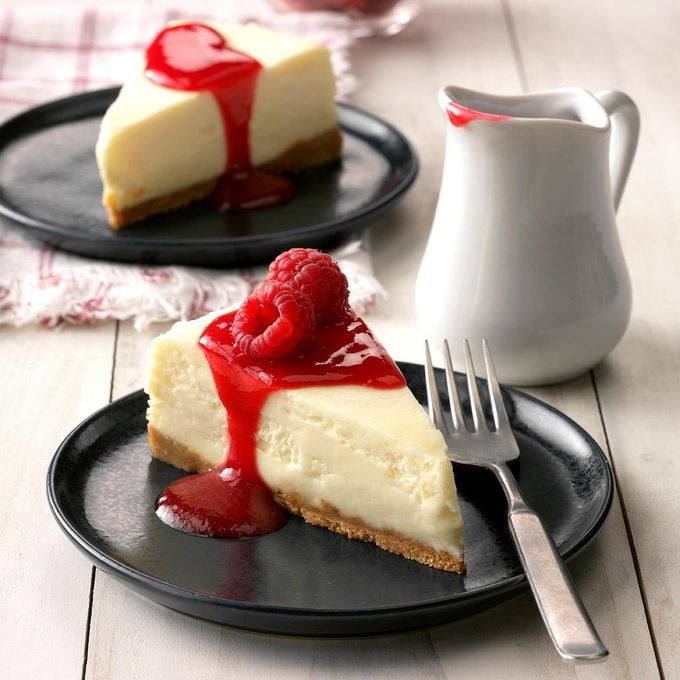
Learning how to make a classic cheesecake is invaluable. Cheesecakes are showstopping, special-occasion desserts that always get some oohs and ahhhs. Once you master the technique for one recipe, you can easily use those skills to make more gorgeous cheesecakes. To start, try a basic recipe like our top-rated traditional cheesecake.
Ingredients:
- 1 cup graham cracker crumbs
- 1 tablespoon sugar
- 3 tablespoons melted butter
- 4 packages (8 ounces each) cream cheese, softened
- 1-1/4 cups sugar
- 1 tablespoon lemon juice
- 2 teaspoons vanilla extract
- 3 large eggs, room temperature, lightly beaten
- Raspberry sauce and sour cream topping to top (optional but tasty)
Also, check if you can freeze cheesecake to keep it fresh.
Step 1: Prep the Crust
Most cheesecakes start with a crumb crust as a base. Before you start crumbling up your graham crackers, though, you’ll have to prep the springform pan.
To do this, wrap the bottom of your springform pan with aluminum foil—even if the pan says leakproof. This is an extra precaution, but one that will give you peace of mind. Then give the inside of the pan a quick spritz of cooking spray.
With the pan ready, you can make a graham cracker crust—super easy. Mix together a cup of graham cracker crumbs, a tablespoon of sugar and three tablespoons of melted butter. Then press this mixture into the bottom of the springform pan. A flat-bottomed measuring cup will help you create a firm, even layer.
Then pop the crust into a 350ºF oven for ten minutes. Remove from the oven, place on a wire rack and cool.
Step 2: Mix Up the Cheesecake Filling
Before you even start beating your cheesecake filling together, make sure that the eggs and cream cheese are room temperature. This is important for getting the smooth, creamy texture that makes this dessert so decadent.
To make the filling, beat together the cream cheese and sugar until nice and fluffy. Use a hand mixer or stand mixer here for the best consistency. Then add in the lemon juice and vanilla extract.
Then add in the eggs, beating until just combined. You don’t want to overmix here.
When the filling is done, pour the batter over the top of the graham cracker crust.
Step 3: Bake
The best way to get a crack-free cheesecake is to use a water bath. Pop the cake pan inside a large, high-sided pan and fill it up about an inch with hot water. This will help prevent cracks and create an evenly baked cake.
Bake the cake at 350ºF for 45 to 55 minutes or until the center is almost set. At the 45-minute mark, tap the side of the cake pan with a wooden spoon. If it looks runny still, let it bake some more. If the cake wobbles slightly, remove it from the oven and cool on a wire rack.
Don’t remove the collar right away. Instead, let the cake cook 10 minutes on a rack. Then run a knife around the edge of the cake and cool another hour before storing in the fridge overnight.
After an overnight stay, remove the collar of the pan, slice and serve. This recipe is great with fresh berries.
Types of Cheesecake
Traditional Cheesecakes

Traditional baked cheesecakes are rich and velvety. They’re made from a combination of cream cheese, eggs and other flavors. There are so many variations and so many are worth trying!
- New York cheesecake is a richer version of a classic plain cheesecake. Recipes typically call for whipping cream and not much additional flavoring. Instead, they’re garnished with fruits or other toppings.
- If regular cheesecake isn’t decadent enough, a chocolate cheesecake recipe will float your boat.
- Pumpkin cheesecakes are quintessential for fall. They’re a great alternative to pie while still allowing you to get your pumpkin fix.
- Fruit and cream are a natural pairing, so fruit cheesecake recipes filled, topped and packed with berries, cherries and citrus are an easy win.
No-Bake Cheesecakes

Baked cheesecakes are the most common, but there are some easy, no-bake cheesecake recipes, too. The no-bake variety doesn’t include eggs and is typically a combination of cream cheese, whipping cream and extra flavors. These desserts are a bit lighter than their traditional counterparts and the oven-free aspect makes them a great choice for warmer months.
- Customized crusts: No-bake cheesecakes are the perfect place to experiment with different crumb crusts. Start by learning how to make Oreo crust, then apply the same technique to Nilla Wafers or gingersnap cookies.
- Whipped topping gives cheesecakes to give it a fluffy, yet creamy, texture. Try a no-bake cheesecake with Cool Whip as a refreshing treat.
- No-bake cheesecakes made with sour cream, like this Black Forest Cheesecake, add a slighty tangy flavor that complements cream cheese nicely.
- Looking for an easy make-ahead dessert? Frozen no-bake cheesecakes can be stored in the fridge for 6-8 months. Simply let thaw in the refrigerator for 3-4 hours before serving.
Cheesecake Desserts

Cheesecake can take other forms other than, well, cake. Cream cheese and cheesecake textures are a great way to add extra richness to cupcakes, bars and other one-bite treats.
- Cheesecake bars: Some events are too casual for a full-blown cheesecake. In that case, combine the ease of a bar with the richness of cheesecake for a dessert that will ensure your pan comes home empty.
- Sometimes called black-bottom cupcakes, cream cheese cupcakes combine cupcake batter and cheesecake batter for a treat few are immune to.
- Mini cheesecakes: Bite-sized cheesecakes are also a great way to turn this showstopping dessert into an everyday treat. Break out a mini muffin pan and you’re set.
Cheesecake Baking Techniques and Tips
Baking cheesecakes can seem stressful. We all want to avoid that dreaded crack in the top! But if you use a few solid techniques, you’ll be on the road to a successful cake. And remember to avoid these common cheesecake mistakes.
Proper Mixing
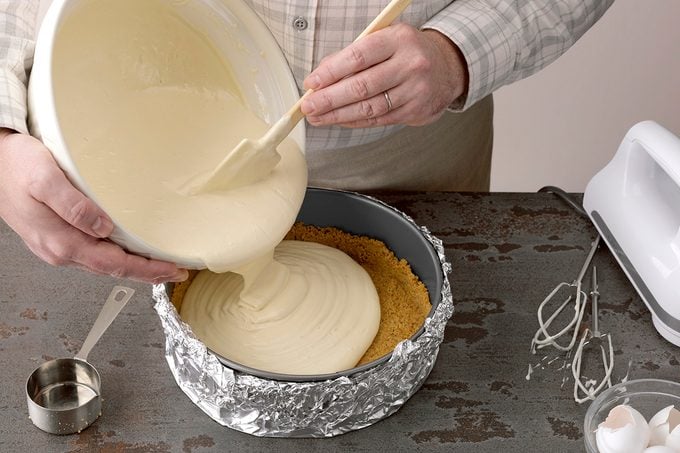
When mixing together a cheesecake batter, it’s very important to use room temperature cream cheese and eggs. This will help the batter come together smoothly.
When adding the eggs into the cheesecake batter, mix until just combined—no longer. The more you beat the eggs, the more air you whip into the batter. Extra air in the batter can cause your cake to crack, so avoid it wherever possible.
Using a Water Bath
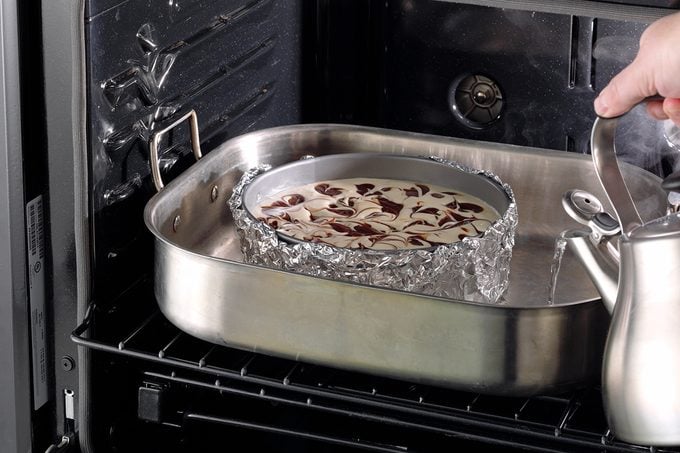
A water bath (or bain-marie if you’re fancy) is a large pan filled with water used to bake delicate recipes like custards and cheesecakes. Using one is easy and it’s a good way to prevent cracked cheesecakes. Even if your recipe doesn’t call for this step, our Test Kitchen recommends it.
To make a water bath for your cheesecake, place a roasting pan or high sided dish into your oven. Your springform pan should fit inside with some wiggle room on all ends. Wrap the springform pan in foil or place it in a slightly larger cake pan to prevent leaks. When it’s time to bake, pop the cake into the pan and fill the pan up with an inch of very hot (nearly boiling water). This will help the cake bake evenly and create a humid environment inside your oven. Humidity can help prevents cracks.
How to Tell if a Cheesecake Is Done
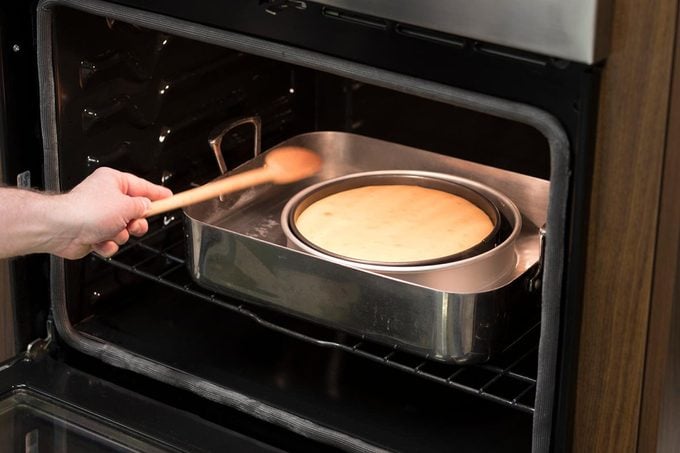
The best way to tell if your cheesecake is done baking is by using the wobble test. To do this, tap the side of your cake pan with a wooden spoon. If the cake ripples a lot, it needs more time in the oven. If it wobbles a bit without ripples, it’s just right. The cake will continue to bake and firm up when it comes out of the oven.
Letting the Cheesecake Cool Correctly

Just because your cake comes out of the oven crack-free doesn’t mean it will stay that way. If it cools too quickly or if the batter is stuck to the side of the pan, it can crack.
That’s where proper cooling techniques come in. To properly cool a cheesecake, remove it from the oven and place on a wire rack to cool. After ten minutes, run a sharp knife around the edge of the cake. Let the cake cool another hour before popping in the fridge. Ideally, cool the cake in the fridge overnight. After its stay in the refrigerator, you can remove the collar and serve.
Cheesecake Baking Supplies
To bake a cheesecake at home, you’ll need your favorite baking supplies—mixing bowls, spatulas, measuring cups and more. A good hand mixer ($50) will be invaluable. Whipping the filling to be as light and fluffy as you need it is challenging to do by hand. Also, a springform pan ($20) is a must. This pan with a removable collar makes it easy to remove and serve your cake. Almost all cheesecake recipes call for this pan, so it’s worth investing in one. Be sure you’ve got a large roasting pan ($55) at home, too for your water bath. If you fall in love with cheesecakes, check out all our favorite specialty gear for baking them.
Check out Taste of Home’s Test Kitchen-approved bakeware line to give your gear an upgrade.
Troubleshooting Tips
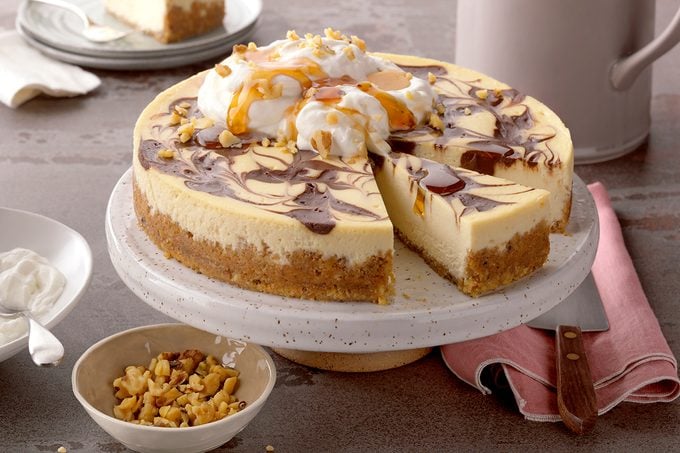
How to Prevent a Cracked Cheesecake
Unfortunately, there’s no single way to prevent a cracked cheesecake. Fortunately, there are lots of easy precautions to take to prevent it from happening. Using a water bath is a great way to prevent cracks as is greasing the pan with cooking spray. Also, be mindful not to overbake. If you try a combination of these tips, you’ll end up with a successful dessert.
How to Fix a Cracked Cheesecake
If your cheesecake cracks, don’t sweat it. You can’t repair the crack, but you can cover it up. A sweetened sour cream topping will give you a flawless finish. You can also top the cake off with fresh whipped cream, chocolate ganache, fruit, cookie crumbs, chopped nuts or whatever you like! The crack won’t affect the flavor at all, so pile on those extra toppings and serve with pride.
How to Add Swirls to a Cheesecake
Many cheesecakes, like this tasty brown sugar and chocolate cake and this blueberry swirl cheesecake, rely on swirling the batter with chocolate or jam to create a pretty design. While some of these finishes can look pretty fancy, they’re so simple to accomplish.
Simple add dollops of the extra flavor over the top of your plain batter and swirl with a toothpick, knife or wooden skewer.
Storing Cheesecake
Homemade cheesecake will keep in the fridge for up to five days. You can also freeze cheesecake if you know you can’t finish it in time. To freeze cheesecake, let it cool completely first. You can freeze the cake whole or in slices. Just be sure to wrap it tightly before popping it in the chill chest.




















